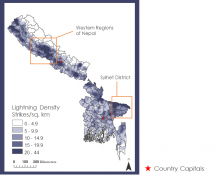 The NASA Global Hydrology Resource Center (GHRC) DAAC published a new Micro Article about NASA DEVELOP’s Hindu-Kush Himalayan Disasters project GHRC collaborated with. A Micro Article is a short, interesting document that brings together data and key science concepts. This study investigated the lightning risks in the HKH region and the correlation between precipitation and lightning. Lightning flash point data collected by the Lightning Imaging Sensor (LIS) onboard both the Tropical Rainfall Measuring Mission (TRMM) satellite and the International Space Station (ISS) from January 2001 to December 2017 were plotted to determine the locations where the highest concentrations of lightning strikes occurred. Data from the United Nations Office for Disaster Reduction (UNISDR) Global Assessment Report for 2015 (GAR15), Oak Ridge National Laboratory (ORNL) Landscan 2016 global population dataset, and NASA’s Shuttle Radar Topography Mission (SRTM) were used to assess the factors that contribute to a population’s vulnerability to lightning activity. Additionally, the team used the TRMM Precipitation Radar (PR) data to identify areas with the highest precipitation rates over Bangladesh and Nepal. A Lightning Risk Map (LRM), created to highlight lightning-prone areas and regions with vulnerable populations, showed that communities in western Nepal and northern Bangladesh are at an increased risk for lightning related injury. A Precipitation and Lightning Correlation was calculated to verify whether areas experiencing heavier precipitation also experienced higher lightning totals. These end products will assist the BMD and the DHM to increase hazard awareness and issue earlier warning times to reduce lightning casualties. You can find this Micro Article at https://ghrc.nsstc.nasa.gov/home/micro-articles/nasa-develop%E2%80%99s-h....
The NASA Global Hydrology Resource Center (GHRC) DAAC published a new Micro Article about NASA DEVELOP’s Hindu-Kush Himalayan Disasters project GHRC collaborated with. A Micro Article is a short, interesting document that brings together data and key science concepts. This study investigated the lightning risks in the HKH region and the correlation between precipitation and lightning. Lightning flash point data collected by the Lightning Imaging Sensor (LIS) onboard both the Tropical Rainfall Measuring Mission (TRMM) satellite and the International Space Station (ISS) from January 2001 to December 2017 were plotted to determine the locations where the highest concentrations of lightning strikes occurred. Data from the United Nations Office for Disaster Reduction (UNISDR) Global Assessment Report for 2015 (GAR15), Oak Ridge National Laboratory (ORNL) Landscan 2016 global population dataset, and NASA’s Shuttle Radar Topography Mission (SRTM) were used to assess the factors that contribute to a population’s vulnerability to lightning activity. Additionally, the team used the TRMM Precipitation Radar (PR) data to identify areas with the highest precipitation rates over Bangladesh and Nepal. A Lightning Risk Map (LRM), created to highlight lightning-prone areas and regions with vulnerable populations, showed that communities in western Nepal and northern Bangladesh are at an increased risk for lightning related injury. A Precipitation and Lightning Correlation was calculated to verify whether areas experiencing heavier precipitation also experienced higher lightning totals. These end products will assist the BMD and the DHM to increase hazard awareness and issue earlier warning times to reduce lightning casualties. You can find this Micro Article at https://ghrc.nsstc.nasa.gov/home/micro-articles/nasa-develop%E2%80%99s-h....






